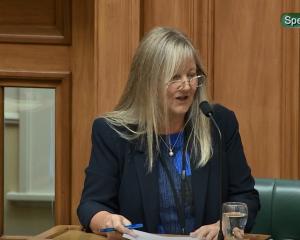Political parties are using motion sensor cameras to catch election hoarding vandals, and passing the evidence on to police.
Both National and the Conservatives acknowledged they were using cameras in some electorates to combat rampant vandalism, theft and damage of signs.
The high-tech measure has not been adopted by other parties, who are relying on volunteers to monitor and respond to vandalism.
National Party campaign manager Jo de Joux confirmed some election teams were using motion sensor cameras to monitor hoardings.
However, she would not say where the cameras had been installed because it would defeat the purpose of having them.
"We're aware a few of our teams may have installed this technology because it's so disheartening for hard-working volunteers to constantly be dealing with the aftermath of hoardings vandalism."
Ms de Joux said any acts of vandalism or theft, where information could identify the relevant person, would be forwarded to police. She would not comment on how many acts had been reported.
Conservative Party candidate Steve Taylor - whose election trailer was deliberately set alight outside his home over the weekend, before attracting a $30 parking fine - said he was installing cameras around some of his hoardings in the New Lynn electorate.
The $150 trail cameras, the same type as used by National, each contained a 12-volt micro-camera which had been camouflaged and disguised to look like tree bark, he said.
"You can hide them in bushes or strap them to a branch. The motion sensor detection activates up to 20-25 metres so ... if there's a motion they pick up, they'll wake up and they'll take a series of shots until the memory card is actually filled up," he said.
"If there's any damage, then the idea is you've got the stills and you can pass them to the police."
The cameras were costly, but cheaper than replacing a damaged hoarding three or four times.
Mr Taylor said vandalism had escalated from spray-painting billboards to cutting out faces, smashing wood and completely removing signs.
Some parties had lost about 50 billboards in the New Lynn electorate over one weekend alone.
"There's no meaningful accountability for the vandalism - you can't catch people. So if you can start putting some technology in place, and basically get the word out that these signs are now being monitored, then we add the risk factor to the vandals."
Labour Party campaign manager David Talbot said the party was not using motion sensor cameras, and they were not a priority. He did not take issue with other parties using cameras.
Green Party national campaign director Ben Youdan said the party did not have the budget for the technology. Electorate teams relied on volunteers to monitor, repair and replace billboards.
The Maori and United Future parties also said they could not afford sophisticated gear, and were relying on volunteers.
The New Zealand First, Internet and Act parties said they were not using the high-tech gear, while Mana did not give a response.
Police do not have any national statistics on the number of complaints laid over election hoarding vandalism.
In Waitemata, a police spokeswoman said there had been a few reports of damage, but there did not appear to be any more than previous campaigns. She would not go into detail on the number of complaints or whether camera evidence had been used.
In Counties Manukau, there had been at least two complaints of damage laid by members of the public. Cameras were not thought to have been used to catch vandals, although that could not be immediately confirmed.
Canterbury police were not aware of any complaints to date.
Police in Auckland and Wellington did not respond to requests for comment yesterday.
- By Matthew Backhouse of APNZ












